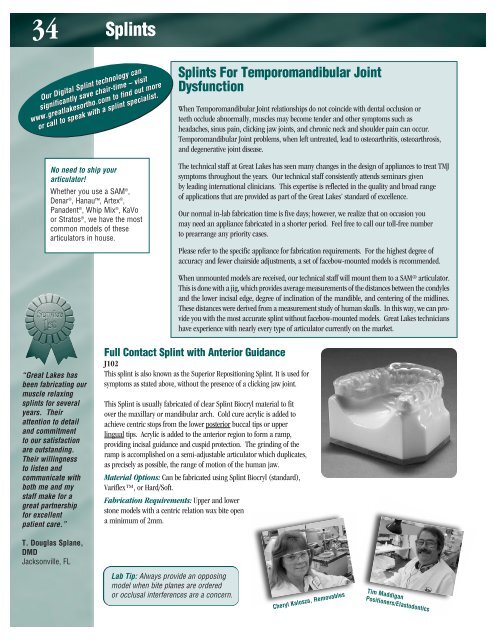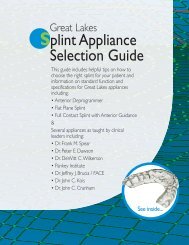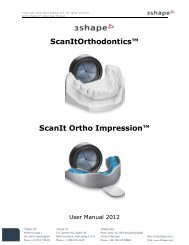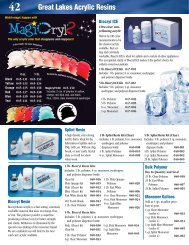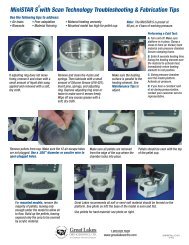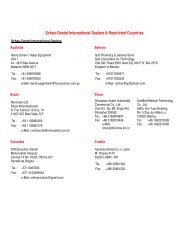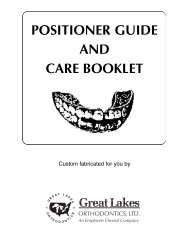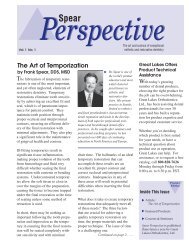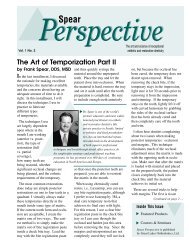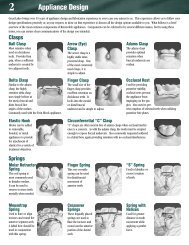Lab Catalog May 1, 2012 - Great Lakes Orthodontics
Lab Catalog May 1, 2012 - Great Lakes Orthodontics
Lab Catalog May 1, 2012 - Great Lakes Orthodontics
Create successful ePaper yourself
Turn your PDF publications into a flip-book with our unique Google optimized e-Paper software.
34 Splints<br />
Our Digital Digital Splint Splint technology technology can<br />
significantly significantly save save chair-time chair-time – visit visit<br />
www.greatlakesortho.com www.greatlakesortho.com to find find out more more<br />
or call call to speak speak with with a splint splint specialist. specialist.<br />
No need to ship your<br />
articulator!<br />
Whether you use a SAM ® ,<br />
Denar ® , Hanau, Artex ® ,<br />
Panadent ® , Whip Mix ® , KaVo<br />
or Stratos ® , we have the most<br />
common models of these<br />
articulators in house.<br />
“<strong>Great</strong> <strong>Lakes</strong> has<br />
been fabricating our<br />
muscle relaxing<br />
splints for several<br />
years. Their<br />
attention to detail<br />
and commitment<br />
to our satisfaction<br />
are outstanding.<br />
Their willingness<br />
to listen and<br />
communicate with<br />
both me and my<br />
staff make for a<br />
great partnership<br />
for excellent<br />
patient care.”<br />
T. Douglas Splane,<br />
DMD<br />
Jacksonville, FL<br />
Splints For Temporomandibular Joint<br />
Dysfunction<br />
When Temporomandibular Joint relationships do not coincide with dental occlusion or<br />
teeth occlude abnormally, muscles may become tender and other symptoms such as<br />
headaches, sinus pain, clicking jaw joints, and chronic neck and shoulder pain can occur.<br />
Temporomandibular Joint problems, when left untreated, lead to osteoarthritis, osteoarthrosis,<br />
and degenerative joint disease.<br />
The technical staff at <strong>Great</strong> <strong>Lakes</strong> has seen many changes in the design of appliances to treat TMJ<br />
symptoms throughout the years. Our technical staff consistently attends seminars given<br />
by leading international clinicians. This expertise is reflected in the quality and broad range<br />
of applications that are provided as part of the <strong>Great</strong> <strong>Lakes</strong>’ standard of excellence.<br />
Our normal in-lab fabrication time is five days; however, we realize that on occasion you<br />
may need an appliance fabricated in a shorter period. Feel free to call our toll-free number<br />
to prearrange any priority cases.<br />
Please refer to the specific appliance for fabrication requirements. For the highest degree of<br />
accuracy and fewer chairside adjustments, a set of facebow-mounted models is recommended.<br />
When unmounted models are received, our technical staff will mount them to a SAM ® articulator.<br />
This is done with a jig, which provides average measurements of the distances between the condyles<br />
and the lower incisal edge, degree of inclination of the mandible, and centering of the midlines.<br />
These distances were derived from a measurement study of human skulls. In this way, we can provide<br />
you with the most accurate splint without facebow-mounted models. <strong>Great</strong> <strong>Lakes</strong> technicians<br />
have experience with nearly every type of articulator currently on the market.<br />
Full Contact Splint with Anterior Guidance<br />
J102<br />
This splint is also known as the Superior Repositioning Splint. It is used for<br />
symptoms as stated above, without the presence of a clicking jaw joint.<br />
This Splint is usually fabricated of clear Splint Biocryl material to fit<br />
over the maxillary or mandibular arch. Cold cure acrylic is added to<br />
achieve centric stops from the lower posterior buccal tips or upper<br />
lingual tips. Acrylic is added to the anterior region to form a ramp,<br />
providing incisal guidance and cuspid protection. The grinding of the<br />
ramp is accomplished on a semi-adjustable articulator which duplicates,<br />
as precisely as possible, the range of motion of the human jaw.<br />
Material Options: Can be fabricated using Splint Biocryl (standard),<br />
Variflex, or Hard/Soft.<br />
Fabrication Requirements: Upper and lower<br />
stone models with a centric relation wax bite open<br />
a minimum of 2mm.<br />
<strong>Lab</strong> Tip: Always provide an opposing<br />
model when bite planes are ordered<br />
or occlusal interferences are a concern.<br />
Cheryl Kalosza, Removables<br />
Tim Maddigan<br />
Positioners/Elastodontics
Flat Occlusal Plane Splint (Full Contact)<br />
J105<br />
The Flat Occlusal Plane Splint is also known as a hard nightguard. The symptoms for using this splint are<br />
the same as for the Full Contact Splint with Anterior Guidance with no clicking joint present.<br />
It is fabricated on the maxillary or mandibular arch. It is a full-coverage splint with an even, flat occlusal<br />
surface for the opposing teeth to contact. The Flat Splint opens the vertical slightly and allows the mandibular<br />
arch to sit comfortably in its own position coinciding with the Temporomandibular Joint.<br />
Material Options: Can be fabricated using Splint Biocryl (standard), Variflex, or Hard/Soft.<br />
Fabrication Requirements: Upper and lower stone models and a centric occlusion bite open a<br />
minimum of 2mm.<br />
Anterior Repositioning Splint<br />
J103<br />
The Anterior Repositioning Splint, also known as the Pull Forward Splint, is used for the same<br />
symptoms as the Full Contact Splint with Anterior Guidance, coupled with a presence of a click in the joint.<br />
This splint is used to recapture anteriorly displaced discs.<br />
This full coverage maxillary splint is used for night wear. These splints are usually fabricated with a wax<br />
bite bringing the mandible into a protrusive position.<br />
The upper splint position is maintained by means of an acrylic flange, which rests lingual to the lower<br />
anteriors and indexes the lower buccal cusps. The flange maintains position even at night when the<br />
jaw relaxes.<br />
The lower splint maintains position with deep buccal, lingual, and incisal indexing of the upper cusp tips.<br />
Material Options: Can be fabricated using Splint Biocryl (standard), Variflex, or Hard/Soft.<br />
Fabrication Requirements: Upper and lower stone models and a protrusive bite open a<br />
minimum of 2mm.<br />
Overlay Splint<br />
J104<br />
The Overlay Splint is fabricated on the Biostar ® machine on either arch. It is usually constructed of<br />
an exceptionally hard polycarbonate material known as Splint Biocryl. As an option, the overlay can be<br />
made of Hard/Soft material. Hard/Soft is a dual laminate of hard polycarbonate and soft vinyl laminate<br />
material. The appliance is formed so that the soft side contacts the teeth on the arch the appliance fits<br />
onto and the hard side faces the opposing arch. This appliance can be used for bruxing patients or can<br />
be used as a base onto which acrylic can be added for other splint designs.<br />
Material Options: Can be fabricated using Splint Biocryl (standard), Variflex, or Hard/Soft.<br />
Fabrication Requirements: Either an upper or lower stone model.<br />
Tanner Splint<br />
J109<br />
The Tanner or Combination Splint is fabricated, using cold cure, on the posterior segments on the mandibular<br />
arch. A lingual bar connects the acrylic segments and ball clasps are customarily used for retention. An<br />
acrylic cap is placed over the lower anterior teeth that also contacts the lingual of the upper anteriors. Incisal<br />
guidance and cuspid protection are built onto the cap. Slight contact of the upper posterior lingual cusps are<br />
present to help maintain mandibular positioning.<br />
Fabrication Requirements: Upper and lower stone<br />
models with a centric relation bite open a minimum of<br />
2mm.<br />
Splints<br />
35
36 Splints<br />
<strong>Lab</strong> Tip: You can download Rx<br />
forms and shipping labels online at<br />
www.greatlakesortho.com<br />
Gelb Splint<br />
J106<br />
The Gelb Splint is used to reposition the<br />
mandible and can also be used to recapture the<br />
disc. The Gelb is fabricated on the mandibular<br />
arch. It is usually fabricated in cold cure to a<br />
wax bite that brings the condyle into a more<br />
anterior, inferior position in the fossa and<br />
increases the vertical opening.<br />
There is posterior coverage connected by a<br />
lingual bar. The standard clasping is two ball<br />
clasps for retention. Slight indexing of the<br />
upper lingual cusps is used to maintain the<br />
position.<br />
Fabrication Requirements: Upper and<br />
lower stone models and a bite to the desired<br />
protrusive position open a minimum of 2mm.<br />
Kois Deprogrammer<br />
A125<br />
The Kois Deprogrammer features a small anterior<br />
stop contacting the lower central incisors and<br />
slightly discludes all teeth. It can be worn at<br />
night to relieve muscle fatigue and headaches. It<br />
can also be used as a diagnostic tool as well as to<br />
determine centric relation and facilitate centric<br />
relation records.<br />
Fabrication Requirements: Upper and<br />
lower stone models. Models will be mounted in<br />
the maximum intercuspal position.<br />
Cranham Deprogrammer<br />
A123<br />
The Cranham Deprogrammer can be used<br />
for equilibration, centric relation records,<br />
or as a nightguard. This appliance features<br />
a small anterior stop contacting<br />
the lower central incisors and slightly<br />
discludes all teeth. It is comfortable for the<br />
patient, requires no retention clasping,<br />
and is easy to use. It is thermal-formed on<br />
the Biostar ® , using 1.5mm Splint Biocryl,<br />
for exceptional retention and fit.<br />
Fabrication Requirements: Upper<br />
and lower stone models. Models will be<br />
mounted in the maximum intercuspal<br />
position.<br />
Soft Biteplate<br />
A126<br />
The Soft Biteplate is used for bruxing habits<br />
or bite disclusion.<br />
Standard coverage<br />
is 5 to 5; can be<br />
fabricated 3 to 3.<br />
Mini Deprogrammer<br />
J111<br />
Highly effective, the Mini Deprogrammer eliminates<br />
muscle-related TMJ facial pain for the vast majority<br />
of patients. Designed with an anterior bite plate<br />
contacting the centrals and laterals only,<br />
the appliance takes posterior teeth slightly out of<br />
contact to remove any interferences that can cause<br />
muscle disharmony and allows the condyles to<br />
properly seat. A flat bite plate option is also<br />
available but will require a greater anterior opening.<br />
To prevent super-eruption of posterior teeth, the<br />
appliance should not be worn more than 10 hours per<br />
day. The Mini Deprogrammer is thermal-formed on<br />
the Biostar ® ,using Splint Biocryl, for exceptional<br />
retention and fit. Designed for optimal comfort, the<br />
splint covers only the anterior teeth and palate.<br />
<strong>May</strong> be contraindicated for patients with internal<br />
derangement.<br />
Material Options: Can be fabricated using Splint<br />
Biocryl (standard), or Hard/Soft.<br />
Fabrication Requirements: Upper and lower<br />
stone model.


